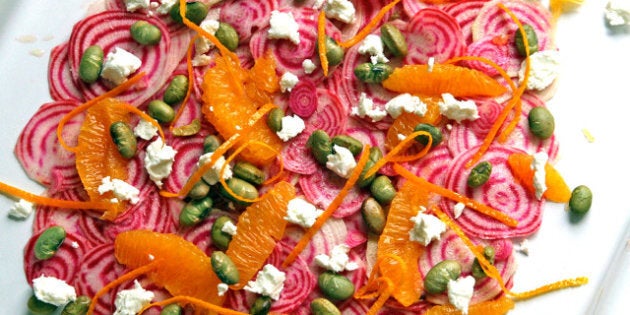
One race morning, I noticed my XC Ottawa teammates Karl and Megan drinking beet juice. I'd read some of the research, but now I was intrigued. Apparently they were tipped off by their friend Dylan Wykes. Dylan, along with Reid Coolsaet and Eric Gillis will be representing Canada in the Olympic Marathon in London, and all of them seem to have incorporated beet juice into their nutrition plans. So have some top pro-cycling teams. The list goes on. Some experts believe doping control will be dealing with many red-colored urine samples from endurance athletes (more on this later . . . .). It was clearly time to investigate further.

The research behind beet juice and performance is compelling. A series of small but mostly well-designed studies have associated beet juice consumption with improved exercise performance. It seems beet juice allows your muscles to perform the same amount of work while using less oxygen, somehow making your body's energy production more efficient. Here are some of the main findings:
- beet juice increased time to exhaustion: cyclists who drank beet juice could ride 16 per cent longer than without beet juice in their diet. The beet juice also allowed them to increase intensity with less oxygen cost.
- beet juice improved performance (1-3 per cent) and power output in 4km, 16km, and 10km cycling time trials. For perspective, if you run a 5 km in 20 minutes, a two per cent improvement is 19:36 - impressive!
- in walkers and runners, beet juice reduced the oxygen cost of walking and moderate and intense running, and increased time to exhaustion
- runners who ate baked beets before running a 5km time trial ran faster (and the last 1.8 km five per cent faster), and had a lower rate of perceived exertion during the first part of the run.
- trained divers could hold their breath almost half-a-minute longer if they drank beet juice before their dive.
- in well-trained rowers, beet juice improved times for a set of 6 x 500m repetitions, especially the later repetitions.
What's the magic ingredient in beets?
Beets contain many health promoting substances, including the antioxidants betalain, resveratrol, and quercetin. But several studies have revealed that nitrates are responsible for the performance benefit of beets. Juice manufacturer "Beet it" now produces a nitrate-free beet juice allowing researchers to have a perfect placebo, and indicating that other compounds in beets aren't responsible for the performance benefits. Although the underlying mechanism is still unclear, recent research has shed light on what's happening.
Our bodies convert the nitrate in beets to nitrite, some of which is converted into nitric oxide. Nitric oxide's role in regulating blood pressure and promoting cardiovascular health is well-established, and research continues to uncover its many health-promoting roles in our body. Nitric oxide regulates vasodilation, relaxing blood vessels and improving blood flow, which could allow more oxygen to reach the muscles. Additionally, it seems that nitric oxide helps muscle mitochondria become more efficient. And a recent study showed that mice on nitrate-rich diets had fast twitch muscles that produced more force than mice on nitrate-free diets.
But aren't nitrates bad?
Until recently, nitrates were considered toxic, and long-term exposure thought to increase cancer risk, which is at odds with the growing body of research highlighting the protective effects of vegetables, many of which are nitrate-rich. In fact, dark leafy greens, which are the richest vegetable sources of nitrates, are all-stars when it comes to promoting health. Many experts question these early studies, and now believe that the naturally occurring nitrates in vegetables may be responsible for some of the cardiovascular benefits of vegetable-rich diets. It's important to remember that nitrates in vegetables occur naturally and come packaged with a host of health-protective compounds (minerals, vitamins, antioxidants).
Do I need to drink beet juice to get nitrates?
Most of the studies used beet juice, likely because it's consistent with other studies, has stable nitrate levels, and has a good placebo (nitrate-free beet juice). Would regular beets (not juiced) have similar effects? Juiced beets allow you to ingest a large quantity of nutrients quickly, and may be more readily absorbed, but evidence suggests that regular beets would have performance benefits as well. Apparently, baked beets improve performance and beet-enriched bread can lower blood pressure, suggesting that nitrates from non-juiced beets also have physiological effects.
What about other nitrate-rich vegetables?
Although not investigated for performance, it's highly possible that other nitrate-rich vegetables would have similar effects to beets. One study found that a diet rich in traditional Japanese foods (plenty of leafy greens) increased plasma nitrite levels and lowered blood pressure, showing that high-nitrate vegetables other than beets may also increase nitric oxide levels.
Vegetables high in nitrates include:
rhubarb, arugula, spinach, celery, cress, chervil, lettuce, beets, chinese cabbage, endive, fennel, kohlrabi, leek, and parsley.
Leafy greens are some of the best nitrate sources. By weight, arugula is the clear winner, boasting 480 mg nitrates/100g (almost twice as much as a cup of beet juice). But that's five cups of arugula. . . so here are some nitrate levels based on more reasonable serving sizes. Note that nitrate values are approximate, since content varies considerably depending on soil, location, time of year, and other variables.
You can get an idea of the nitrate content of other vegetables in this table or this publication. Remember -- a health-promoting diet should include nutrients from a variety of vegetables, so don't limit your vegetable intake to high-nitrate varieties. Consider that broccoli and carrots, which are low in nitrates, offer plenty of disease-fighting nutrients.
How much beet juice did studies use?
Performance benefits were found when study participants either drank 500 ml beet juice for four to six days, and also for a single 500 ml dose 2.5 hours before exercise testing (500 ml juice reportedly contained about 380-500mg nitrate). More recent studies have tested concentrated beet juice shots (70 ml, about 300 mg nitrate), which seem to be more popular with athletes. A recent study found that consuming just 100 mg nitrate reduced blood pressure, but these researchers didn't investigate exercise performance.
Seeing red? Some people notice red urine after eating beets. This condition is harmless, and occurs when beet pigments enter the bloodstream before digestive bacteria break them down
Recommendations
Although beet juice has shown promise at improving exercise performance, larger scale studies in more diverse populations are needed (for example, more studies in highly trained athletes and females -- most studies looked at young male recreational athletes). Also, the safety and effectiveness of ingesting high levels of nitrate from one type of vegetable for extended periods is not known. Do not consume commercially available nitrate or nitrite salts, which can cause potentially life-threatening conditions.
A safe bet is to always include a wide variety of vegetables in your diet (high and low nitrate), which have proven health benefits, and consider increasing the proportion of high nitrate containing vegetables closer to important training blocks or events. For non-beet options, eat pre-race meals that are rich in nitrates (e.g., big salads, greens, tabbouleh, spinach lasagna), or add rhubarb to your morning oats (according to this study, oats might help enhance nitric oxide production too).
Here's a tasty way to incorporate beets into your diet. Adapted from our cookbook Food for Thought: Healing Foods to Savor (sorry, it's out of stock -- but second edition, full of great health information and high nitrate recipes, like Garlicky Greens or this great combo -- Beets & Arugula with Curry Vinaigrette -- is coming out very soon!).
Chocolate Beet Bread with Pecans
This is the "sweet treat" version that tastes like a decadent rich chocolate cake, even though there's no butter or oil. You can make it even healthier by reducing the sugar and substituting some whole wheat flour for the all-purpose flour. Of course, adding extra chocolate chips is always a good option!
1/3 cup chopped pecans
1 15-oz can sliced beets (not pickled), drained, reserving 1/2 cup juice
1 ½ cups sugar
3 large eggs
1 tsp. vanilla extract
1½ cups all-purpose flour
3/4 cup cocoa powder
1½ teaspoons baking soda
¼ teaspoon salt
1/3 cup semisweet chocolate chips
1. Preheat the oven to 350 degrees.
2. Prepare two 8x4x2-inch loaf pans by spraying with a nonstick baking spray or little butter or non-trans margarine. Toast the nuts by placing them on a baking sheet, and place in the 350-degree oven for 5 to 7 minutes.
3. Puree the beets with the reserved juice in a blender or food processor and transfer to a large bowl. Stir in the sugar, eggs, egg white and vanilla extract.
4. In a separate bowl or measuring cup combine the flour, cocoa powder, baking soda and salt. Add the dry mixture to the beet batter and mix well. Stir in chocolate chips and nuts.
5. Pour the batter into the loaf pan. Bake for 30 to 35 minutes. Test by touching the top of the loaf; if the cake springs back and there's no indentation, it's done. Run a table knife around the edges of the pan and turn out onto a rack to cool.
Makes 16 servings. Each serving provides about 180 calories, 4 g protein, 4 g fat (1 g sat), 40 mg cholesterol, 34 g carbohydrate, 2 g fiber, 200 mg sodium, 135 mg potassium, and 15 mg calcium.
About Sheila, and more Nutrition Digest Articles here.
For more sports science and nutrition updates, follow Sheila on Twitter